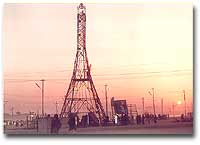|
|
|||
India's management skills deliver the Kumbha Mela. |
|||
|
Any developed country that had anything a fraction of what the Kumbha Mela was, would have hyped it up, marketed it and congratulated itself. In India, world history's largest ever people-event spread over six weeks, passed off without fuss or incident. Perhaps it's a sign of India's self-confidence that it doesn't chortle about what it has just brought off. its of a piece with India's nonchalance when criticism is heaped on it. India just does it and keeps going! The colour and the theatre of the event have been well-covered by the world media. Puzzled audiences the world over have been shown the strange and varied lot called Indians -30 million of them- trudging up to a river, without a prompt or any publicity, to take a dip and assert a uniqueness all their own. No alibis! But not enough has been said about what it took to organise so mammoth a festival, which cannot be canceled by anyone's diktat nor can restrictions be placed on anyone who wanted to be there. The Kumbha Mela arrives with a force all its own and is a ticket less, open festival that is everyone's right to participate in. The administration faced a logistical nightmare. Planning began several months before in Allahabad in UP, a state much reviled for its disorder and lawlessness. Supply of water, food, electricity, telecom, grocery, fuel, shelter was planned. Special camp-site space had to be reserved for hundreds of religious and quasi-religious organisations. For over three months, construction went on at the Kumbha site. Take in these figures: a 3000 acre temporary township, featuring 140 km of specially laid roads 500,000 tents 16000 street lights 150 watch towers 28 police stations 17000 toilets 5000 phones a hospital and 20 clinics That is the hardware. The software required to run so vast a project called for an equally staggering set of numbers: 40 companies of para-military forces 18000 policemen 200 doctors 100s of shops 6000 conservancy workers clearing upto 200 tonnes of garbage per day The political situation in the country being what it is, security issues had to be addressed: 12 anti-sabotage squads 8 mine detection teams 2 commando groups Tens of 'trouble-spotters' mingling with the crowd 6 infra red scanners for night vigil Closed circuit surveillance TV network Now, the reviews. Whew.... ....but how did it all play? Sandipan Deb a columnist for 'Outlook' was there and notes of the pilgrims :"...two unbelievable crore [20,000,000!] of them on one single day, the holy Mauni Amavasya, and if all of them stood in single file the line would have stretched from Allahabad to Miami." Not a single untoward incident took place. No epidemic, no riots. Many were 'lost' but helped to be 'found' again. A few tempers ran high but becalmed in time. Religious groups declared 'hostilities', but it was all more theatre than violent. Hundreds of voyeuristic foreign photographers pried on the lives of Indians: they were shooed off and not attacked. Here is Sandipan Deb reporting again: "The Maha Kumbha is history's biggest logistical exercise of its type and it is organised amazingly well. Kumbhnagar is spotlessly clean from roads to public latrines the garbage is invisible, the officials are polite and efficient, and it's a miracle that the policemen on duty are not cracking up..." 'India Today' called it the "Kleenex Kumbha" and said: "the Kumbha has been a revelation of India's hitherto hidden skills in civic management." The Maha Kumbha such as the one just passed occurs but once in 144 years. Long before the next one arrives, India will have learnt to replicate the Kumbhnagar success all across the country.
March,2001
|
A watch-tower in Kumbha Nagar
|
||

